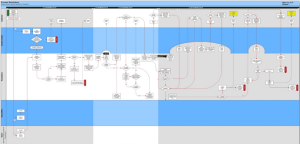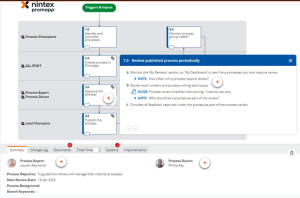Advanced process mapping techniques to elevate operational performance
Written by Chief Automation Officer, George K. Mehok
For the past two decades, industry leaders in manufacturing, aerospace, and energy infrastructure have shifted their engineering functions away from the physical world into a virtual one, developing breakthrough innovations using digital twin technology to design, build and test the most complex engineered systems. This article explores how businesses can leverage the same digital twin technology to improve operational functions, reduce costs, improve quality, and lower the risk of regulatory non-compliance.
What is a digital twin?
A digital twin is a virtual representation of an object or system that spans its lifecycle, is updated from real-time data, and uses simulation, machine learning, and reasoning to help decision-making.
History of digital twins
Dr. Michael Grieves (then on faculty at the University of Michigan) is credited with first applying the concept of digital twins to manufacturing in 2002 and formally announcing the digital twin software concept. Eventually, NASA’s John Vickers introduced a new term — “digital twin”— in 2010.
However, the core idea of using a digital twin to study a physical object can be witnessed much earlier. NASA pioneered the use of digital twin technology during its space exploration missions of the 1960s when each voyaging spacecraft was exactly replicated in an earthbound version that was used for study and simulation purposes by NASA personnel serving on flight crews.
What are process twins?
A process twin is a digital representation of how systems and people work together to facilitate the desired business outcome. Are those systems and people involved synchronized to operate at peak efficiency, or will delays and processing errors in one affect others, increasing cycle times, cost, and ultimately, your customers’ satisfaction?
Process twins can help determine the precise timing that ultimately influences overall effectiveness, and sheds light on opportunities that will improve the quality and timeliness of the business outcome.
For operational managers that must deal with the day-to-day challenges of solving complex business operational issues, creating a digital process twin provides the information and visibility necessary to optimize operational workflows by identifying inefficiencies, non-compliance, and quality issues.
What is process mapping?
Process mapping is the best method for organizations to create a process twin of your business. Simply put, a process map is a digital representation of how something is done. It communicates the sequence of steps or activities that need to take place to achieve a particular outcome. Additionally, process maps are a way to show who is responsible for fulfilling each activity and how success is measured.
The tools to produce process maps may vary. However, the primary purpose of it remains the same: to document important information that will help organizations and teams operate efficiently.
Benefits of process mapping
Process mapping takes your organization’s important operational information and clarifies who does what, how to do it, and why it matters. If done right, process mapping increases operational efficiency.
Deliver a Better customer and staff experience
Having processes that are accurate and easy to understand ensures the best possible experience, no matter who is serving the customer.
Increase efficiency and productivity
A clear understanding and visual representation of how a process actually works helps teams identify improvements and increase efficiency and productivity.
Simplify compliance management
Simplify audits, compliance, and certification—create and update process and procedure content faster with process maps that are generated from text and can be dynamically updated and easily shared with external auditors.
Improve quality and consistency
With clear ownership and accountability, staff can create, use and update their own process documents. It’s easy for them to identify and implement opportunities for improvement in their day-to-day work.
Reduce Costs
Current, standardized processes make it easier to identify areas in your business where you’re wasting time or money, or where processes are repeated.
Increase Business agility
Driving change in your business is easier and faster when everyone has accurate, up-to-date process information at their fingertips.
What is process mapping software?
Process mapping software allows the business user to define the process objective, who is responsible, triggers, inputs, requirements, outcomes, and how success is measured. This information is stored in a centralized online repository, where anyone from the organization can create or edit processes, view or manage processes and documents, and provide feedback or suggest improvements.
Traditional process mapping might have been documented in something that resembles the image below – complex and difficult to read and understand, let alone to maintain. That is why it is typical for an IT analyst to create the process document once, typically using Visio or another static design tool. Within days, it is obsolete and rarely, if ever, referenced.

Next-generation process mapping software creates a dynamic digital version of your business activity. The process map below is a simplified version of the same process. Rather than have every step visible on the map, the information has been layered and presented in a way that allows the reader to easily access only what they need.

All the important process information—documents, triggers, inputs, outputs, stakeholders, policies, procedures, systems, and participants—is organized in a simple, easy-to-use interface. With this level of information, an organization can review the process for efficiency and adherence to compliance standards. However, the most valuable aspect of the digital process twin is to analyze the time and effort associated with a given activity.
Conclusion
Designing and maintaining a standards-driven approach to process documentation utilizing digital process twin technology will deliver transformative benefits and lead to operational process excellence.
Please contact us to learn more about process mapping best practices and software.




